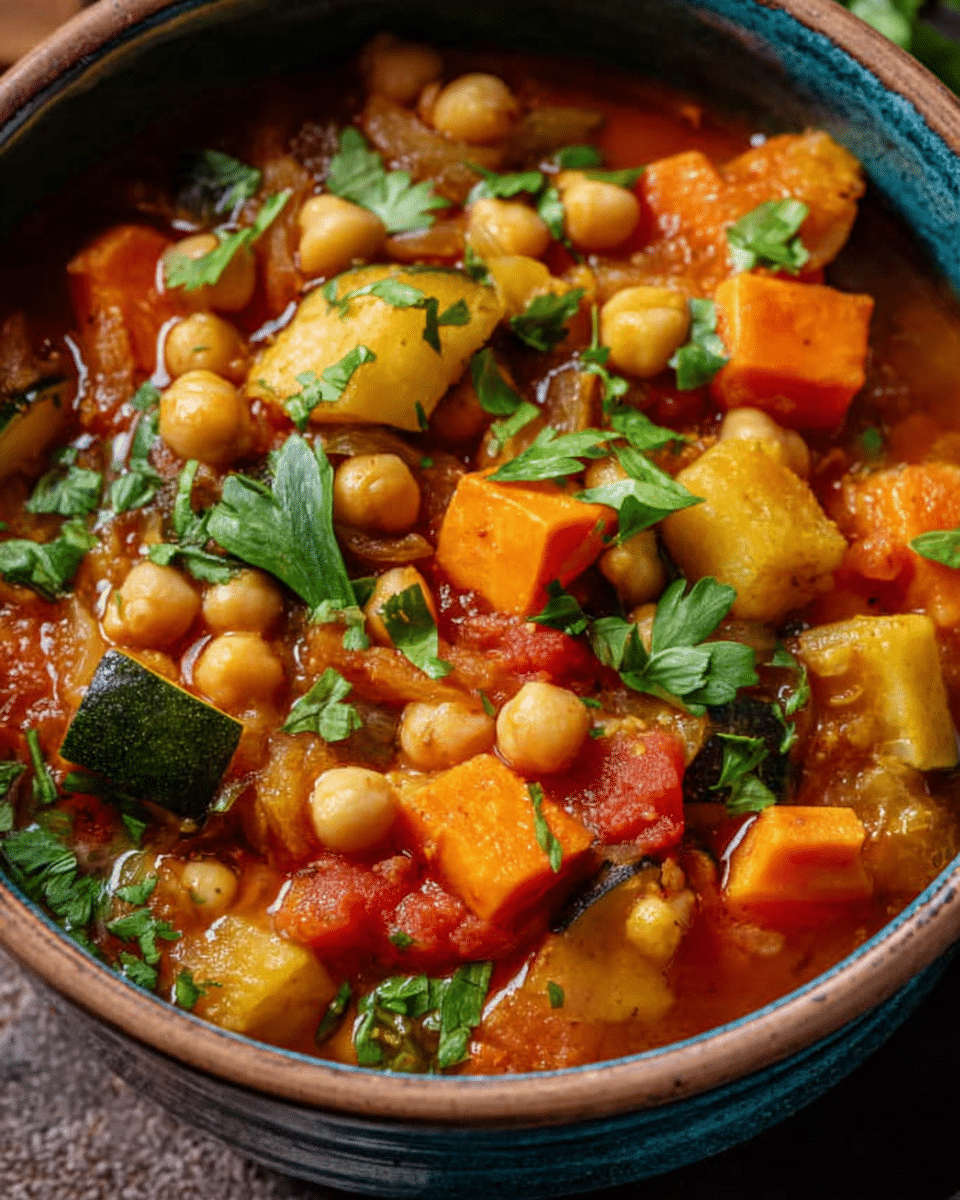The Moroccan Vegetable Tagine is a deliciously spiced, hearty dish filled with tender vegetables like sweet potatoes, carrots, and zucchini, all simmered in rich, flavorful broth. The cumin, turmeric, and cinnamon provide a warm and aromatic base, making every bite incredibly comforting.
This tagine is the perfect dish to cozy up with on a cool evening, and it’s easy to customize based on what you have in your pantry. You can switch up the vegetables or even add dried fruit like apricots or raisins for a sweet contrast to the savory spices. Whether you serve it over couscous, rice, or enjoy it on its own, it’s a flavorful, satisfying meal that’s vegan and gluten-free.
Full recipe:
Ingredients:
-
2 tablespoons olive oil
-
1 large onion, chopped
-
2 garlic cloves, minced
-
2 medium carrots, sliced
-
1 zucchini, chopped
-
1 sweet potato, cubed
-
1 cup canned chickpeas, drained and rinsed
-
1 ½ cups vegetable broth
-
1 can diced tomatoes (14.5 oz)
-
1 tablespoon ground cumin
-
1 teaspoon ground cinnamon
-
1 teaspoon turmeric
-
1 teaspoon paprika
-
Salt and pepper to taste
-
1 cup fresh cilantro, chopped
-
1 cup dried apricots, chopped (optional)
-
1 tablespoon honey (optional)
Directions:
-
Heat olive oil in a large pot over medium heat. Add onions and garlic and sauté until soft, about 3 minutes.
-
Add carrots, zucchini, and sweet potatoes to the pot. Cook for 5-7 minutes, stirring occasionally.
-
Stir in the cumin, cinnamon, turmeric, paprika, salt, and pepper.
-
Add the diced tomatoes, vegetable broth, chickpeas, and apricots (if using). Bring to a boil.
-
Reduce heat to low and let simmer for 25-30 minutes, or until the vegetables are tender.
-
Drizzle with honey, if desired, and sprinkle with fresh cilantro.
-
Serve over couscous, rice, or enjoy it as a hearty stew.
Prep Time: 10 minutes | Cooking Time: 40 minutes | Total Time: 50 minutes Kcal: 280 kcal | Servings: 4 servings
History of Moroccan Tagine
The tagine has been a staple of Moroccan cuisine for centuries, with its origins dating back to the Berbers, the indigenous people of North Africa. The unique cooking vessel, also called a tagine, is a clay pot with a conical lid that helps to trap steam and circulate it throughout the dish, allowing the ingredients to cook slowly and retain their moisture. Over time, the tagine has evolved to include a variety of meats, seafood, and vegetables, but the vegetable tagine remains a beloved vegetarian option. The Moroccan vegetable tagine reflects the country’s agricultural abundance, making use of local, fresh produce.
The Flavors of Moroccan Vegetable Tagine
The magic of a Moroccan vegetable tagine lies in the combination of spices that infuse the vegetables. Traditional Moroccan spices like cumin, turmeric, cinnamon, and paprika create a deep, warm, and aromatic base that enhances the natural sweetness of vegetables such as carrots, sweet potatoes, and zucchini. Adding dried fruits like apricots or raisins can balance the heat of the spices with a touch of sweetness, a hallmark of many Moroccan dishes.
One of the key elements of the dish is its versatility. Whether you use root vegetables like potatoes, carrots, and sweet potatoes or lighter veggies like zucchini, bell peppers, and tomatoes, the tagine can adapt to whatever is in season or available in your pantry. The slow-cooking process ensures that the flavors develop and the vegetables become tender and juicy, making each bite an experience of both texture and taste.
The Health Benefits of Moroccan Vegetable Tagine
Moroccan vegetable tagine is not only delicious but also packed with nutrients, making it an excellent choice for those seeking a healthy meal. The vegetables used in the dish are rich in vitamins, minerals, and fiber, contributing to overall health and well-being. For example, carrots are high in beta-carotene, which supports eye health, while sweet potatoes are a great source of antioxidants and fiber.
Moreover, the chickpeas in the recipe are a fantastic source of plant-based protein, making the dish filling and nourishing. Chickpeas are also known for their ability to promote digestive health and stabilize blood sugar levels. The combination of these wholesome ingredients, along with the heartwarming spices, creates a meal that is not only tasty but also nourishing for the body.
Cooking with a Tagine
While a traditional tagine pot is ideal for cooking this dish, it’s not strictly necessary. You can easily make a Moroccan vegetable tagine in a heavy-duty pot or Dutch oven, which will also allow for slow cooking. The most important thing is to cook the ingredients on low heat to allow them to simmer and soak up the spices and broth.
Cooking in a tagine pot, however, offers an added benefit: the conical lid creates a steam-cooking effect, which helps retain the moisture in the ingredients and ensures a more tender result. This method also helps the spices permeate the vegetables evenly, so each bite is infused with flavor.
How to Serve Moroccan Vegetable Tagine
Moroccan vegetable tagine is a versatile dish that can be served in a variety of ways. Traditionally, it’s served with couscous, a type of steamed semolina grain that absorbs the flavorful juices of the tagine. The light, fluffy couscous complements the rich, spiced vegetables perfectly, making for a well-balanced meal. You can also serve it with rice, quinoa, or even crusty bread to soak up the sauce.
For an extra touch of authenticity, serve the tagine in individual clay bowls, which help to retain heat and enhance the dish’s presentation. A sprinkle of fresh cilantro on top adds a burst of color and a fresh, herby flavor that brightens the rich, earthy spices of the tagine.
The Versatility of Moroccan Vegetable Tagine
One of the best things about Moroccan vegetable tagine is its adaptability. You can easily tweak the recipe to suit your dietary preferences or what you have available in your kitchen. If you want to add some protein to the dish, you can incorporate tofu, tempeh, or even roasted nuts like almonds or pine nuts.
For those who love heat, adding a pinch of cayenne pepper or chili flakes will give the dish an extra kick. On the other hand, if you prefer a milder flavor, you can reduce the amount of spices or omit some of the hotter ingredients, such as paprika or cayenne.
You can also experiment with different vegetables based on what’s in season. In the summer, bell peppers, tomatoes, and eggplants would make great additions to the dish. In the fall and winter months, root vegetables like parsnips, rutabagas, and butternut squash can be used to make a heartier, more substantial tagine.
Moroccan Vegetable Tagine and Its Cultural Significance
Food plays an integral role in Moroccan culture, and the tagine is no exception. The slow-cooked meal is often shared among family and friends, making it a dish that encourages togetherness and community. The way the tagine is served – often in a communal pot with everyone gathered around – reflects the Moroccan value of hospitality and sharing.
The use of spices in Moroccan cooking also has cultural significance. Many of the spices used in Moroccan tagines have been traded for centuries, and they represent the country’s position as a crossroads for various cultures and trade routes. Moroccan cuisine blends Arab, Berber, and Mediterranean influences, which is evident in the combination of spices and ingredients used in this dish.
Conclusion
Moroccan vegetable tagine is more than just a meal; it’s an experience. The aromatic spices, tender vegetables, and heartwarming flavors make it a dish that is loved by many. Whether you’re looking for a comforting winter dish or a fresh summer meal, Moroccan vegetable tagine fits the bill. Not only is it incredibly delicious and healthy, but it’s also a dish that allows for customization, so you can make it your own. Its cultural significance adds to the richness of the experience, making it a wonderful dish to prepare and share with others.
This dish is perfect for anyone seeking to explore the flavors of Morocco or those looking to enjoy a plant-based meal that’s both filling and nourishing. No matter how you serve it, Moroccan vegetable tagine is sure to impress and satisfy everyone at the table.






